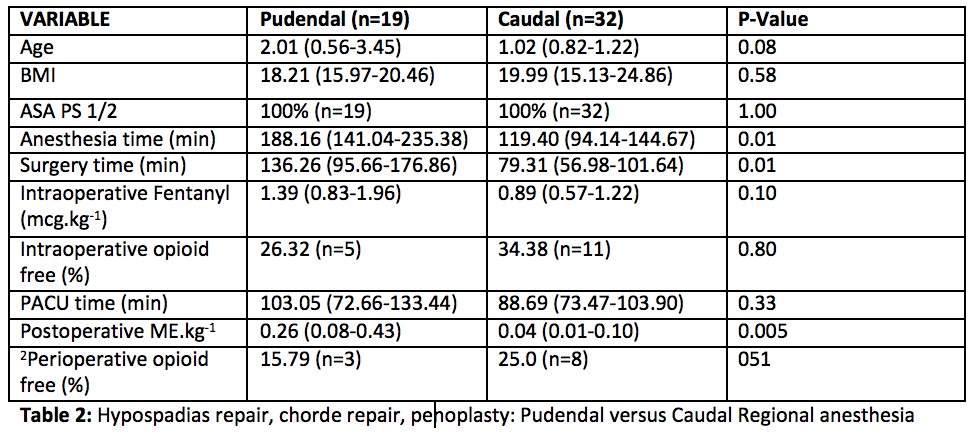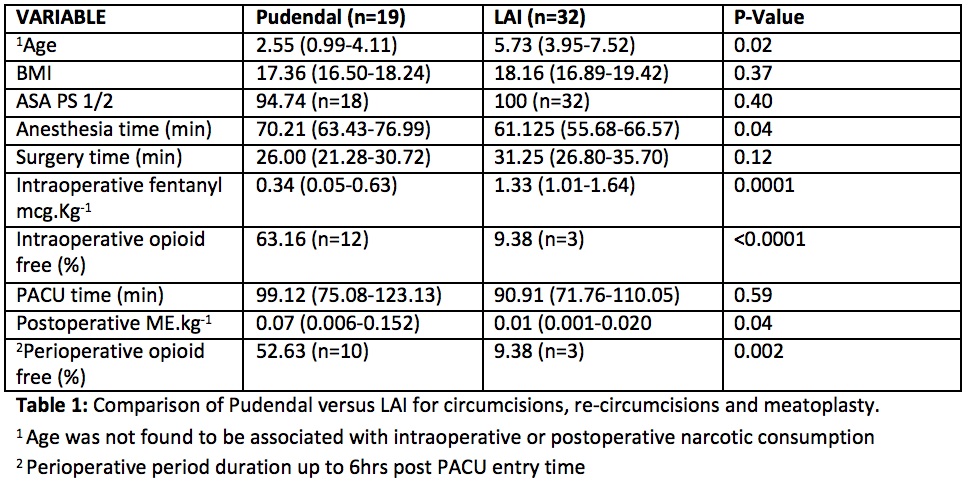NM-224
Pudendal nerve blocks in pediatric urologic procedures
1Saks A, 1Lynch E, 2Morganstern B, 2Palmer L, 1Dowling O, 2Kars M, 2Hagen J, 2Barnett N
1Donald and Barbara Zucker School of Medicine at Hofstra/Northwell, New Hyde Park, NY, USA; 2Cohen Children's Medical Center at Northwell Health, New Hyde Park, NY, USA
Background: Pediatric urologic procedures are the most common surgeries performed in the US and are accomplished with the assistance of several regional anesthetic techniques. There is limited objective data available to differentiate the most effective technique for these procedures in regard to post-operative outcomes. A retrospective chart review was established to assess frequently implemented regional techniques. Pudendal nerve block (PNB) was achieved utilizing ultrasound guidance at the entrance of the pudendal canal. Caudal anesthesia (CA) was done per standards of care, and dorsal penile blocks were accomplished with local anesthetic infiltration (LAI) at the discretion of the surgical team.
Methods: Groups were compared with respect to age, BMI, operative and anesthetic time, total intraoperative fentanyl dose, time to discharge from PACU, morphine-equivalent dose in the surgical care unit and proportion of patients opioid free during the intra- and perioperative period. Descriptive statistics such as means (95% CI) and percentages were used to describe groups. Student t-tests were used to compare groups with respect to parametric continuous data. Non-parametric continuous data was compared using an appropriate non-parametric test. Categorical data was compared using Chi square and Fisher Exact tests. Data was analyzed using SATA 14.0. Comparisons were performed for PNB versus LAI in circumcision, re-circumcision and meatoplasty as well as PNB versus CA in hypospadias repair, chorde repair, and penoplasty.
Results: When comparing PNB and LAI a 4.42-fold decrease in the amount of intraoperative fentanyl required in patients receiving PNB was seen. In addition, significantly more patients in the PNB group were able to remain opioid free intraoperatively (p <.0001) and perioperatively (p=. 002). Fewer data points showed statistical significance when comparing PNB to CA. Mean anesthesia and surgical times were longer for patients receiving PNB (p=0.01), and patients receiving CA required fewer morphine equivalents than patients receiving PNB (p=0.005). These results demonstrate that PNB may be superior to LAI for circumcisions and may not be inferior to CA for hypospadias repairs.
Conclusion: Regional anesthetic techniques have been developed to improve postoperative outcomes and reduce the use of opioids in an attempt to limit their adverse effects. The widespread use of ultrasound guidance has made these techniques more accessible. The results of this study may promote utilization of the Pudendal nerve block for common pediatric urologic procedures and should warrant further investigation.
Top













